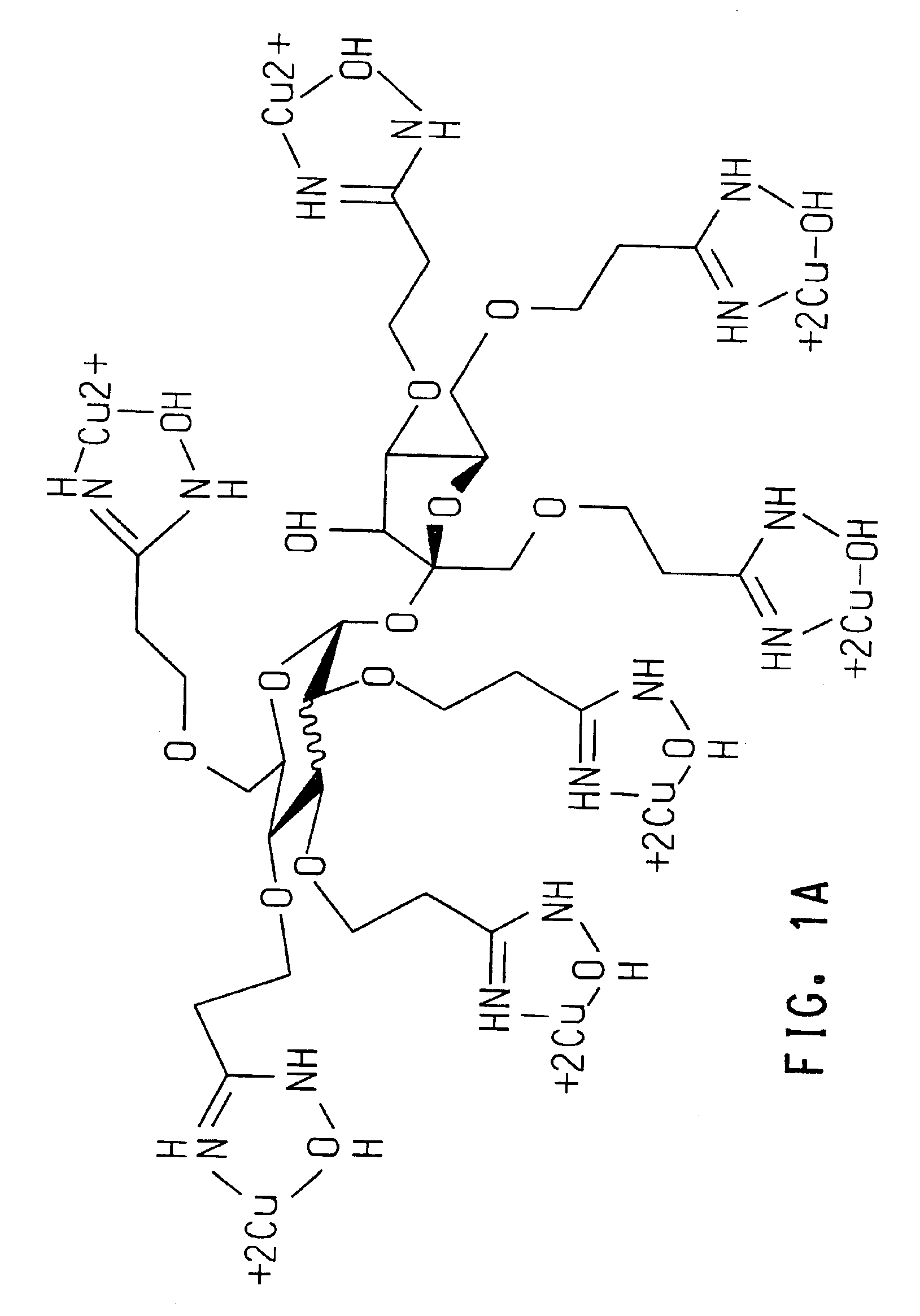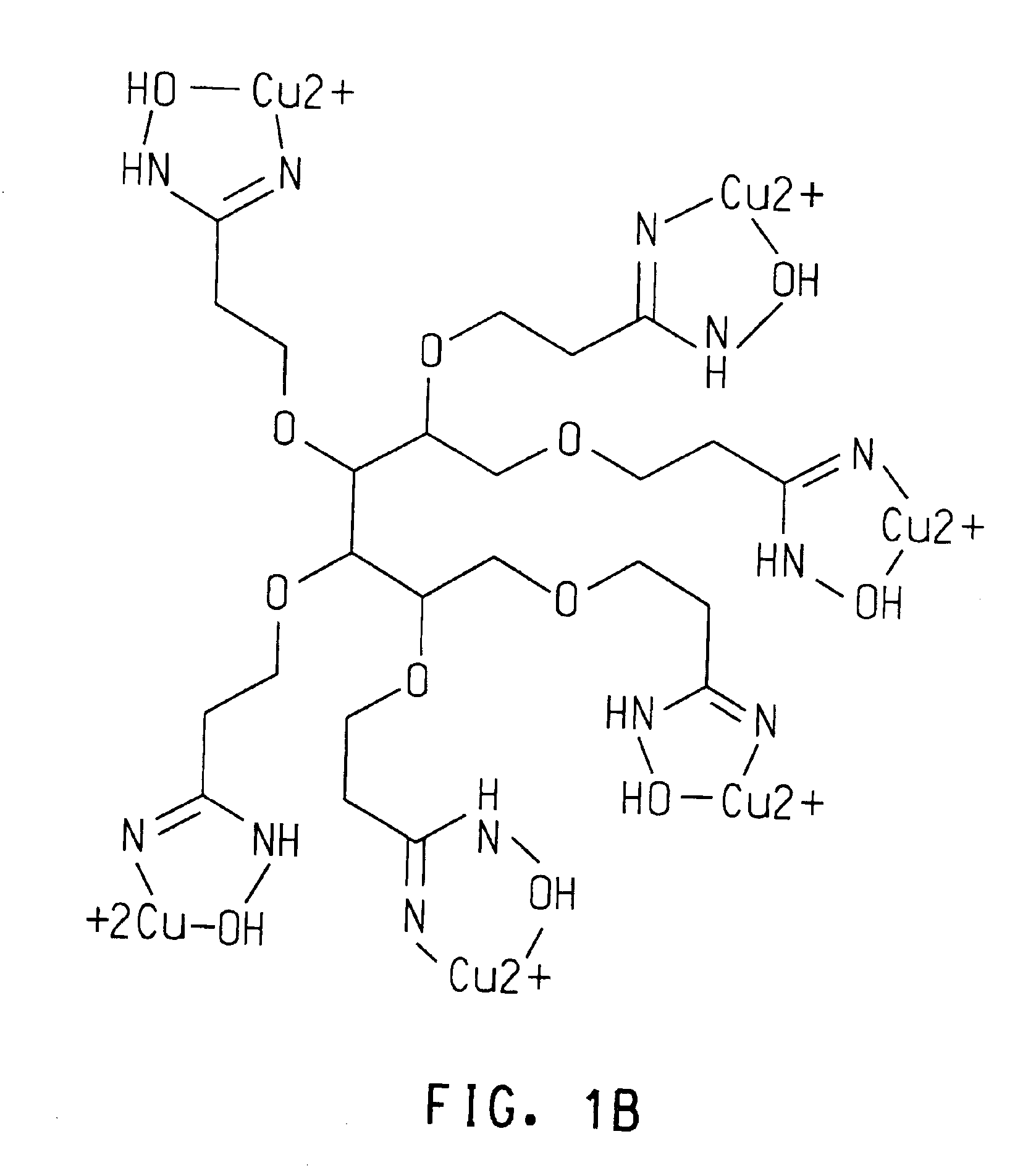Copper complexes and their use as wood preservatives
a technology of copper complexes and preservatives, which is applied in the field of copper complexes, can solve problems such as significant economic losses and environmental impact of arsenic and chromium used in cca-treated lumber
- Summary
- Abstract
- Description
- Claims
- Application Information
AI Technical Summary
Benefits of technology
Problems solved by technology
Method used
Image
Examples
example 1
Preparation of Copper Complex of the Amidoxime of Sorbitol
[0060]A solution of copper sulfate pentahydrate (14.77 g, 165 mmol, 5.6 eq) in water (200 mL) was added rapidly via addition funnel to the ammonia-containing solution of the product of the reaction of CE-Sorb6 with hydroxylamine hydrochloride (as described above). Initially, the solution turned a dark green and contained some solids. A blue color appeared upon further addition of the copper solution, and quickly dissipated on stirring. Additional ammonium hydroxide (19.7 g, 152 mmol) was added via pipette during the course of the addition of the copper solution. The resulting dark blue solution was stirred overnight, pH 8-9, and then diluted with water to a total volume of 2100 mL (theor.=5000 ppm Cu).
[0061]ICP Analysis of 100:1 solution: 45.1 ppm Cu.
example 2
Preparation of Copper Complexes of Polyhydroxamic Acid
[0062]The preparation of polymeric hydroxamic acid compounds is essentially that as described in U.S. Pat. No. 3,488,329. That process was modified by using hydroxylamine water solution, instead of by neutralizing aqueous hydroxylamine by addition of base to hydroxylamine hydrochloride.
[0063]Poly(methyl vinyl ether)-maleic anhydride copolymer (5 g) was suspended in 20 g of water and to this was added 2.2 g of triethylamine or 1.8 g of pyridine. To this suspension was added 1.5 g of hydroxylamine as a 50 wt % solution in water. The solution became warm and was allowed to stir overnight at room temperature. Aqueous solutions of 3 g copper chloride, 5.2 g copper nitrate, or 4.5 g of copper acetate were prepared in 10 mL of water and then added to the polymer solution followed by 8.2 g of concentrated ammonium hydroxide.
[0064]The resulting blue solutions could be imbibed into wood.
example 3
Procedure for Laboratory Imbibement of SYP Wood
[0065]Using standard laboratory glassware and a vacuum pump, a wood impregnation system as described in AWPA Standard E10-01 was used to imbibe small pre-weighed Southern Yellow Pine (SYP) wood blocks (¾″×¾″×¾″). The imbibement vessel was evacuated for 15 min and then the vacuum was broken by introduction of the imbibement solution. The imbibement solution was prepared by diluting the preparations given in Example 1 with water to a copper concentration of 5000 ppm. The blocks were imbibed under atmospheric pressure for 15 minutes. The blocks were allowed to drip dry and were then weighed wet to ensure that the wood was penetrated with the imbibement solution. The blocks were then dried overnight in a convection oven at 55° C. Weights of the dried blocks were then recorded.
PUM
| Property | Measurement | Unit |
|---|---|---|
| temperature | aaaaa | aaaaa |
| temperature | aaaaa | aaaaa |
| temperature | aaaaa | aaaaa |
Abstract
Description
Claims
Application Information
 Login to View More
Login to View More - R&D
- Intellectual Property
- Life Sciences
- Materials
- Tech Scout
- Unparalleled Data Quality
- Higher Quality Content
- 60% Fewer Hallucinations
Browse by: Latest US Patents, China's latest patents, Technical Efficacy Thesaurus, Application Domain, Technology Topic, Popular Technical Reports.
© 2025 PatSnap. All rights reserved.Legal|Privacy policy|Modern Slavery Act Transparency Statement|Sitemap|About US| Contact US: help@patsnap.com



